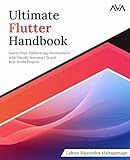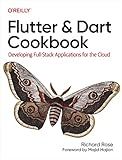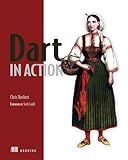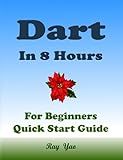Best Dart String Manipulation Guides to Buy in November 2025

Flutter Design Patterns and Best Practices: Build scalable, maintainable, and production-ready apps using effective architectural principles



Ultimate Flutter Handbook: Learn Cross-Platform App Development with Visually Stunning UIs and Real-World Projects (English Edition)



Flutter and Dart Cookbook: Developing Full-Stack Applications for the Cloud



Flutter Cookbook: 100+ step-by-step recipes for building cross-platform, professional-grade apps with Flutter 3.10.x and Dart 3.x, 2nd Edition



Flutter in 7 Days: Build user-friendly apps with widgets and navigation (English Edition)



Dart in Action



Dart Programming, In 8 Hours, For Beginners, Learn Coding Fast: Dart Programming Language, Crash Course Tutorial, Quick Start Guide & Exercises


String manipulation in Dart involves various operations to manipulate the contents of a string. Here are some common techniques:
- Concatenation: You can concatenate multiple strings using the '+' operator. For example:
String str1 = "Hello"; String str2 = "World"; String result = str1 + " " + str2; // "Hello World"
- Length: To get the length of a string, you can use the length property. For example:
String str = "Hello"; int stringLength = str.length; // 5
- Substring: You can extract a substring from a string using the substring() method. The method takes the start and end indices and returns the desired substring. For example:
String str = "Hello World"; String subStr = str.substring(6, 11); // "World"
- Case conversion: Dart provides methods to convert a string to uppercase or lowercase using toUpperCase() and toLowerCase() methods, respectively. For example:
String str = "Hello World"; String upperCaseStr = str.toUpperCase(); // "HELLO WORLD" String lowerCaseStr = str.toLowerCase(); // "hello world"
- Splitting: You can split a string into multiple substrings using a delimiter with the split() method. For example:
String str = "Hello,World,Dart"; List splitStr = str.split(","); // ["Hello", "World", "Dart"]
- Parsing: Dart provides methods to parse strings into other data types like integers and doubles. For example:
String str = "10"; int intValue = int.parse(str); // 10
String doubleStr = "3.14"; double doubleValue = double.parse(doubleStr); // 3.14
- Replacing: Dart provides the replace() method to replace occurrences of a substring within a string. For example:
String str = "Hello World"; String replacedStr = str.replaceFirst("World", "Dart"); // "Hello Dart"
These are just a few examples of string manipulation techniques in Dart. By combining these methods creatively, you can perform a wide range of manipulations on strings according to your requirements.
How to remove whitespace from a string in Dart?
To remove whitespace from a string in Dart, you can use the replaceAll() method with a regular expression pattern that matches whitespace characters. Here's an example:
void main() { String str = ' hello world '; String trimmedStr = str.replaceAll(RegExp(r'\s+'), ''); print(trimmedStr); // Output: helloworld }
In the above example, the replaceAll() method is used with a regular expression pattern RegExp(r'\s+'). The \s matches any whitespace character, and the + specifies that one or more occurrences of whitespace should be replaced. The replacement string is specified as an empty string '' to remove the whitespace characters.
Note that if you want to remove only leading and trailing whitespace, you can use the trim() method instead:
void main() { String str = ' hello world '; String trimmedStr = str.trim(); print(trimmedStr); // Output: hello world }
In this case, the trim() method removes leading and trailing whitespaces from the string, but preserves any whitespace characters within the string.
How to replace a substring within a string in Dart?
In Dart, you can use the replaceFirst method of the String class to replace a substring within a string. Here's an example:
void main() { String originalString = 'Hello, World!'; String substringToReplace = 'World'; String replacementSubstring = 'Everyone';
String newString = originalString.replaceFirst(substringToReplace, replacementSubstring);
print(newString); // Output: Hello, Everyone! }
In this example, we first define the original string 'Hello, World!'. Then, we specify the substring 'World' that we want to replace and the replacement substring 'Everyone'. We use the replaceFirst method to replace the first occurrence of the substring in the original string, resulting in the new string 'Hello, Everyone!'. Finally, we print the new string using print(newString).
How to format a DateTime object as a string in Dart?
To format a DateTime object as a string in Dart, you can use the intl package which provides the DateFormat class. Here's an example of how to format a DateTime object:
- Import the intl package:
import 'package:intl/intl.dart';
- Create a DateFormat object with the desired format:
var formatter = DateFormat('yyyy-MM-dd HH:mm:ss');
- Format the DateTime object using the format method:
var now = DateTime.now(); var formattedDate = formatter.format(now);
In this example, the format 'yyyy-MM-dd HH:mm:ss' represents the year, month, day, hour, minute, and second of the DateTime object. You can customize the format pattern according to your needs.
The formattedDate variable will contain the formatted DateTime as a string.
How to format a number as a currency string in Dart?
To format a number as a currency string in Dart, you can use the NumberFormat class from the intl package. Here's an example:
import 'package:intl/intl.dart';
void main() { double number = 1234.56;
// create a NumberFormat instance for currency formatting final currencyFormat = NumberFormat.currency(locale: 'en_US', symbol: '\$');
// format the number as a currency string String result = currencyFormat.format(number);
print(result); // $1,234.56 }
In this example, we create a NumberFormat instance called currencyFormat and set the locale parameter to 'en_US' for US English formatting. The symbol parameter is set to '$' to represent the currency symbol.
Then, we use the format method of the currencyFormat instance to format the number as a currency string. The resulting string is stored in the result variable.
Finally, we print the result, which would display '$1,234.56'.
